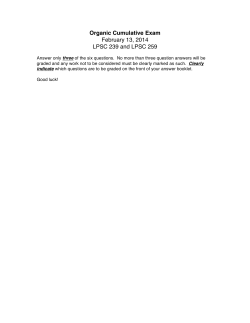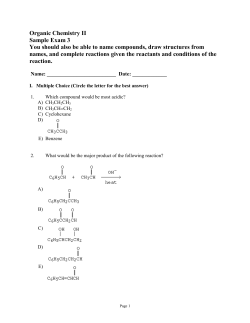
December 17, 2012 Naming Covalent Compounds What is a covalent compound again?
December 17, 2012 Naming Covalent Compounds What is a covalent compound again? A compound composed of two or more elements that are bonded together because of sharing electrons. ➡ Nonmetal and a nonmetal ****Naming covalent compounds is completely different than naming of the ionic compounds***** Rules: 1.) Use Prefixes to tell how many of each element. The second element ends in -ide. Example 1: N O Dinitrogen pentoxide Example: N Cl Dinitrogen tetrachloride 2.) If the first element listed has just one, it does not get a prefix: A.) NO Nitrogen dioxide B.) CO Carbon Dioxide 3.) The second element always gets a prefix no matter what: A.) CO Carbon Monoxide B.) NO Nitrogen Monoxide 4.)Cannot reduce covalent compound formulas. A.) N O will not be reduced to NO They are completely different compounds. Practice: Write the names of the following. 1.) SO 2.) ICl 3.) PBr Write the formulas for the following: 4.) carbon tetrachloride. Date: December 18, 2012 Bell Work: 1.) Li P 2.) N O 3.) CSe 4.) SIyt Naming Ionic Compounds What are the names of the ions? Naming Captions (+ charge) K name of element Potassium Cation or Potassium Ion Ca Calcium Cation or Calcium Ion Naming Anions (- charge) Cl name of element ending in "ide" Anion Chloride Anion Or Chloride Ion O Oxide Anion or Oxide ion We know how to get the oxidation number from the periodic table for the main group of elements. Group # 1, 2, 13, 14, 15, 16, 17, 18 +1, +2, +3, +/-4, -3, -2, -1, none What are the oxidation numbers listed for the elements not listed (groups 3->12 "transition metals" In the periodic table given to you look at the key for oxidation states, find the element and the ion could be a couple of choices. Example: Iron (Fe) could be a +2, +3, or +6. In the periodic table given to you look at the Key for oxidation states, find the element and the ion could be a couple of choices. Ex. Iron (Fe) could be +2, +3, or +6 We use Roman numerals to differentiate from the different ions. Fe Iron (II) ion Fe Iron (III) ion Fe Iron (VI) ion Roman Numerals: Number: 1, 2, 3, 4, 5, 6, 7 Roman Numeral: I, II, III, IV, V, VI, VII Naming Ionic Compounds : NO PREFIXES!!!!!!! NaCl Sodium Chloride BaCl Barium Chloride K O. Potassium Chloride January 2, 2013 Bell Ringer: Write formulas for.... 1.) Silver Bromide 2.) Chromium III Oxide 3.) Silicon Dioxide Reviewing Homework: Transition Metals 1.) Palladium IV Sulfide 2.) Titanium II Oxide 3.) Titanium III Oxide 4.) Titanium IV Oxide 5.) Tin II Oxide Notes: Polyatomic Ions 1.) Write the formula Tin (IV) Sulfate The 2 on the outside of the parenthesis means that there are two sulfate groups (so technically 2 S and 8 O. 2.) Strontium Carbonite Sr(CO2) would be understood to have a one outside the parenthesis, and since it is a one, we can drop the parenthesis. 3.) Write the name for the formula for the ionic compound. RuPO The one tripled up going to the phosphate ion +3, so the superscript of the one phosphate must also triple going up to the ruthenium ion, so the charge in doubt is +3. Ruthenium III phosphate 1.) Sodium Carbonate 2.) Copper II Sulfate 3.) KClO 4.) NH OH 5.) Fe(ClO ) January 3, 2013 Bell Ringer: Name Mn(CrO ) 1.) Silver Hydroxide 2.) Magnesium Nitrate 3.) Magnesium Sulfate 4.) Iron III Sulfate 5.) Platinum IV Phosphate 6.) Ammonium Hydroxide 7.) NaNO 8.) NH Cl 9.) BeCO 10.) Ca(ClO ) 11.) Fe(BrO ) Mixed Review: 1.) NiCl 2.) Na O 3.) SeO 5.) RuCO 6.) Silver Oxide 7.) Dinitrogen Pentoxide 8.) Chromium (III) Phosphate 9.) Copper (II) Oxide 4.) NaClO 10.) Aluminum Bromide January 4, 2013 1.) SF 2.) Na S Review Homework from Yesterday. Write a paragraph about the way we name compounds. In order to properly name compounds you first need to determine which elements that you are working with. You will need to check to see if these elements are both nonmetals or a metal and a nonmetal. If they are two nonmetals, then you know that the chemical bond will be a COVALENT BOND. With covalent bonds, we always will name the elements based on how many of element there are in the compound. To name it if it has more than one of the same element you will give it a prefix, such as di-, tri-, quad-, or penta-. However the starting element if it has just one you will not use a prefix. If you have a metal and a nonmetal, the bond will be IONIC. In ionic bonds, there are NO PREFIXES! Metals always go before the nonmetal. You will check to see the ions first and write them down. Then you will cross the element charges from one element to the other and write them as a subscript. For Polyatomic Ions, use the Polyatomic sheets to help you with the charges and then follow the same procedure for ionic compounds. Acids An acid is a distinct type of molecular compound. Usually refers to a solution in water of one of these special compounds rather than to the compound itself. Binary acids are acids that consists of two elements, usually hydrogen and one of the halogens - F, Cl, Br, and I. Oxyacids are acids that contain of hydrogen, oxygen, and a third element (usually a nonmetal) Most acids are based in water and have very particular properties . Hydrofluoric acid Hydrochloride acids Nitric acids (Nitrate) Sulfuric acid (Sulfate) Phosphoric acid (Phosphate) Acetic Acid (acetate) Carbonic Acid (carbonate) January 7, 2013 Bell Ringer: Name the following. a.) CS b.) AgNO c.) VCO Practice Sheet #1-36 1.) LiCl 2.) KOH 5.) FeCl 9.) Al (SO ) 3.) HgOH 4.) kCl 6.) LiNO 7.) NH OH 8.) Cu O 10.) N O 11.) NaOH 12.) CO 13.) CoO 14.) Pb(OH) 15.) NH NO 16.) NA CO 17.) HgO 18.) Zn(NO ) 19.) Cu PO 20.) CsOH 21.) Li O 22.) Ca(OH) 23.) CaBr 25.) Cu SO 26.) FeCO 27.) SO 29.) Al(OH) 30.) NaClO 31.) NaIO 24.) Fe O 28.) Ba(BrO ) 32.) Na SO January 9, 2013 Bell ringer: What percentage of this class is male? *grab a calculator* Review of formula writing from yesterday. Percent Composition - percent by mass of each element in a compound. What is the percent composition of H O? Percentage Paragraph: In order to find the Percent Composition of a compound you will first need to find the value of the atomic weights of each element in the compound. Once you have the atomic weights, you will need to multiply the atomic weight by how many of each element is in the compound. This will give you the atomic weight of the number of that particular element. Then you need to add the weights of each element in the compound together to find the total mass (atomic weight). Once you have the total you are going to want to find the part of each element out of the entire total which will look like a fraction. You want to solve the fraction and get a decimal. Once you have a decimal, you will want to multiply it by 100 to get a percentage. Do that for each element. January 10, 2013 Bell Ringer: what's the difference between molecular formula and empirical formula? Molecular Formula - a chemical formula that shows the number and kinds of atoms in a molecule, but not the arrangement of the atoms. Example: C H O Empirical Formula - a chemical formula that shows the composition of a compound in terms of the relative numbers and kinds of atoms in the simplest ratio. Example C H O -> C H O How to Find the Empirical Formula: pg 247 #3 CaBr 20.0 compound 1.) A compound is found to contain 63.52% iron and 36.48% sulfur. Find it's empirical formula. Paragraph on Finding Empirical Formulas. First you find the percentage of the element in the compound if not already given to you. Then you would divide the percentage of the element into its atomic weight (which you would find on the periodic table of elements). Then look to see which quotient of each element is the smallest. Divide that January 11, 2013 What is the empirical formula for C H ? Practice 1&2 on page 249. 1.) Determine the molecular formula of the compound with an empirical formula of CH and a formula mass of 78.110 amu. 2.) A sample of a compound with a formula mass of 34.00 amu is found to consist of 0.44g H and 6.92 O. Find it's molecular formula. Write a paragraph. In order to find the molecular formula from the empirical formula Pg. 249 #4 If 4.04g of N combine with 11.46g O to produce a compound with a formula mass of 108.0 amu, what is the molecular formula of this compound?
© Copyright 2025





















